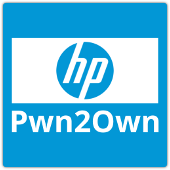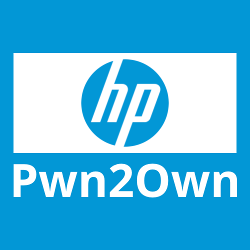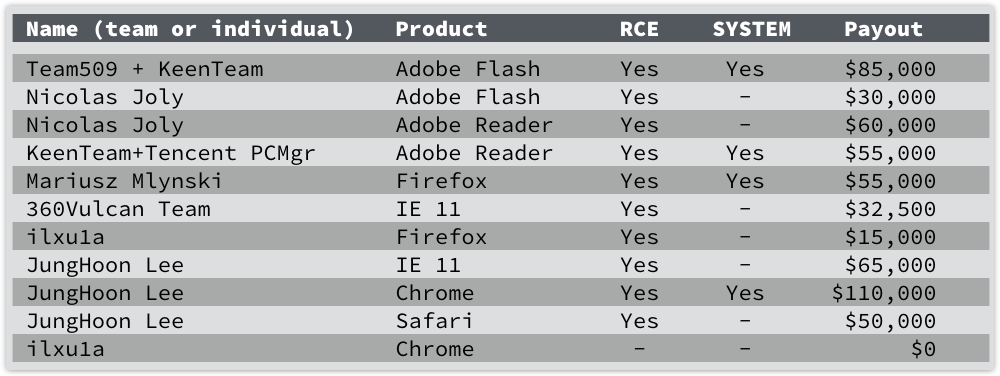 Pwn2Own has become something of an institution on the North American computer security conference circuit.
Pwn2Own has become something of an institution on the North American computer security conference circuit.
It’s vulnerability research, but not in its calm and undramatic “here’s a list of the many bugs we fixed this month” form.
Usually, finding a potentially-exploitable security hole gets your name listed against one of dozens of CVEs patched in the latest release of ${insert_browser_name} or ${choose_OS_type}.
If you’re not already employed by the relevant vendor, you might also get a quiet bug bounty payout.
Just finding a crash-causing bug such as a buffer overflow or a use-after-free bug is often enough on its own.
→ A buffer overflow is where you trick a program into accepting more data than will fit into the memory allocated for it. A use-after-free is when you trick a program into writing into a block of memory that was already handed back to the operating system. This typically overwrites chunks of memory that control other parts of the program. So, with a mixture of analysis and experimentation, you may be able to leverage this sort of bug from “just cause a crash” to “sneakily take over control.”
If you can envisage how determined attackers might wrangle the bug into tricking your software into doing something of their own choosing, you might as well assume it’s a bug worth patching promptly.
The bug part is called a vulnerability, because it represents a weak spot in security.
The part where a crook purposefully abuses the vulnerability for his ends is called an exploit, for obvious reasons.
The process of working out how to exploit a vulnerability is known as weaponising it. (For better or worse, war plays a significant metaphorical role in the computer security industry.)
One you’ve found a vulnerability, you can take two paths:
- Spend time to produce a proof-of-concept (Poc) exploit. The PoC helps vendors prioritise the danger, and may suggest additional mitigations for other related, but so-far unknown, vulnerabilties.
- Assume the worst, patch the vulnerability and move on. If you know your car’s brakes are spongy and badly-adjusted, you don’t need to do a few laps of the a test track before you decide to get them fixed.
The Pwn2Own path
Pwn2Own unashamedly takes the first approach above, and turns the process into a spectator spectacle.
The competition is a sort of Software Security Superbowl, where touchdowns are scored by sitting down behind a laptop screen and publicly pwning the computer, armed only with a browser.
You win a prize if your attack would have allowed a crook to infect the computer with malware without any of the standard system defences, such as ASLR, DEP, sandboxing and so on, throwing up any sort of warning.
To add a bit more spectator excitement into what really ought to be straight science and engineering, if there is more than one entrant in any category, they go into bat in a randomly-chosen order.
If the first guy succeeds (each attacker gets a maximum of 30 minutes), he wins the grand prize for that category and the prize money is halved for the next entrant, no matter that his exploit might be quicker and slicker.
But if the first batter strikes out, the full prize money goes forward.
There are bonuses for taking your exploit further, notably if you can promote your attack code from a user-level login to SYSTEM.
On Windows, SYSTEM privilege is a special sort of administrator or root level access that as good as gives you full control over the computer.
As a regular user, you can install software for your own use, access files that you already own, and much more, but you can’t install kernel drivers, read other people’s files, or change the low-level system configuration.
With SYSTEM, you can do all of those things, and you can do them quietly and unobtrusively in the background.
In this year’s Pwn2Own, promoting a remote code execution exploit to SYSTEM level was worth a $25,000 bonus, whether you were the first competitor into bat or not.
The Pwn2Own results
Here’s how the Pwn2Own “live attacks” paid out:
According to HP, the 11 attacks shown above, of which 10 were successful and four ended up with full SYSTEM-level access, resulted in the following count of vulnerabilities to be fixed:
Windows itself: 5 bugs Microsoft IE 11: 4 bugs Mozilla Firefox: 3 bugs Adobe Reader: 3 bugs Adobe Flash: 3 bugs Apple Safari: 2 bugs Google Chrome: 1 bug
A good result all round, especially for JungHoon Lee, who took home $225,000.
As HP joked in its own summary of the event, JungHoon was only out at bat for two minutes for his Chrome attack, giving him a rate of pay of “roughly $916 per second.”
By that metric, Mariusz Mlynski did way better, as his $55,000 payout for pwning Firefox took just 0.542 seconds, according to HP, so he earned at over $100k per second.
But those are silly numbers – if you converted Mlynski’s rate of pay to a 40-hour week, he’d be on close to three-quarters of a trillion dollars a year.
Even JungHoon’s $916/second comes out at about $7B when you annualise it.
Of course, that 0.542 second time to pwn Firefox was the result of an unstated amount of work and preparation done before the event.
In short, Pwn2Own is a bit of a mixture of drama and research.
Proponents will argue that it helps to keep bugs and vulnerabilities in the fronts of our minds; but critics might say that it makes security molehills into theatrical mountains.
Where do you stand on having a Software Security Superbowl of this sort?


Dan
Positive – but not for the stated reason. Positive, because companies WILL understate the seriousness of a vulnerability, if theres a chance they can get away with it. I’ve seen repeatably companies that underplay it, claiming some imaginary mitigating factor, make the vulnerability not-so-serious.
Like:
Me: “You shouldn’t use a Java applet for this”, Them: “Yeah, but the chrome sandbox makes it impossible to exploit”.
Or “this buffer overflow extremely hard to exploit” (read; neigh impossible) “because of ASLR”.
We need Pwn2Own, because it gives us working scenarios that we can point to, to help drive home the point that: “No, the sandbox doesn’t save you”, “No, ASLR is not a magic bullet” and “Yes, you need to take every vulnerability in YOUR product, very very serious”.
Paul Ducklin
Actually, I think that _is_ part of what is referred to as “valuable” in the stated reason.
jimcsecurity
I voted Positive for this. I think Pwn2Own is worth every cent/penny. While I acknowledge there is a certain amount of drama/spectacle about the event, the work the security researchers are doing is invaluable. The vendors are essentially having penetration testing carried out and since it’s being done by outsiders it can be more objective than an internal audit (please don’t misunderstand me, internal audits are still worthwhile).
The researchers are putting in the effort, expertize and time into creating these exploits just like a malicious hacker would. While any vendor would state their product is as secure as possible and meets all of their quality assurance checks the researchers can still exploit/pwn them. I believe that the vendors are having flaws found that would not otherwise be found or worse are exploited maliciously before a patch is available i.e. a zero day flaw.
For example in 2013; 2 particularly noteworthy flaws were an exploit for Internet Explorer that raised the exploits integrity level (its permission level or authority level) from low to medium and the LDRHotpatch ASLR/DEP bypass. This latter exploit used an undocumented API call to carry out its malicious intent. This exploit lead to the later development and inclusion of the Banned Functions mitigation into Microsoft EMET. Microsoft even mentioned (in an SRD blog post) how novel/unheard of these exploits really were and how correcting them was far from trivial.
I believe this particular flaw may have been eventually exploited as a zero day flaw rather than being disclosed responsibly. This is the real benefit I see from Pwn2Own. The security researchers think outside of the box in that they come up with exploit methods that the vendors never even thought of or even knew were possible and exploit them. Since they are being disclosed responsibly we all benefit from the experience/knowledge the vendors obtain from the researchers.
I consider this event pivotal to the development/enhancement of security for us all since vendors can and do become complacent in their development practices. It’s only when they are shown how badly a product can be exploited and how vulnerable it really is, only then will the vendor take notice and make the necessary changes and possible improvements to their quality assurance process to protect it, otherwise the product would stay as it is.
I realize many people would not agree with me but I think it is in all of our interests they this competition/event continues. Thank you.
Ready. Set. Pwn.
Positive. Nothing’s wrong with mixing business with pleasure I say.
Anonymous
I think this is a positive thing because it draws more attention to the fact that there are vulnerabilities in all the software we use, and the more this sort of thing is brought into public focus the more vulnerabilities get fixed, the more general awareness there is of the risks, and it all works together to hopefully create a more secure future for everybody.
I do, however, see a potential downside. Some of the researchers involved in these types of competitions “save” the vulnerabilities and exploits they discover for the competition (in order to make money from their work, which is understandable), creating a potential window if insecurity where an attacker may utilise those very exploit. The delay in disclosure feels less than responsible.
This is the only reason I prefer active bug bounty programs as it allows immediate disclosure and (hopefully) fixes to be created, while still rewarding researchers for their efforts appropriately.
jimcsecurity
The potential downside that you mention is a very valid point. Unfortunately, not all vendors participating in Pwn2Own have a bug bounty programme, until they do, you’re right this downside will remain.
It will be interesting to see how Google’s all year round Pwnium bug bounty programme progresses/takes shape rather than the once a year competition.